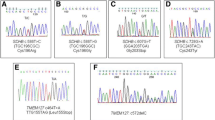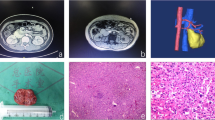Abstract
Recently, the succinate dehydrogenase subunit D (SDHD) gene has been reported as one of the major susceptibility genes for pheochromocytoma (PCC) and paraganglioma (PGL). In addition, loss of heterozygosity (LOH) on chromosome 11, mainly in 11 q23 and 11 q13, is observed frequently in PGL. Based on the fact that mutation frequency of the SDHD gene is less than that of allelic loss at chromosome 11 q, where the SDHD gene is located, this region may contain other candidate tumor-suppressor genes involved in pathogenesis of PCC/PGL. The tumor-suppressor gene Men1 located in 11 q13 is responsible for multiple endocrine neoplasia type 1 (Men1). However, the involvement of the Men1 gene in tumorigenesis of sporadic PCC/PGL is yet to be determined. To understand the roles of the two tumor-suppressor genes and LOH on chromosome 11q in Chinese patients with sporadic PCC or PGL, we performed mutation detection of the SDHD and Men1 genes in tumors from 35 Chinese patients with PCC/PGL; we also did LOH analysis at chromosome 11q for 25 patients out of the 35. No mutation was found in all of 35 patients. However, LOH was detected at one or more loci in 11 of the 25 (44%) tumor samples. The highest frequency of LOH occurred at D11S2006 (41%). Our results suggested that mutation in SDHD or Men1 gene was not found in Chinese patients with sporadic PCC/PGL. However the loss of chromosome 11q might be critical in development of PCC or PGL.
Similar content being viewed by others
References
Baysal, B. E., Ferrell, R. E., Willett-Brozick, J. E., et al. (2000). Science 287, 848–851.
Hirawake, H., Taniwaki, M., Tamura, A., et al. (1999). Biochim. Biophys. Acta 1412, 295–300.
Riemann, K., Sotlar, K., Kupka, S., et al. (2004). Cancer Genet. Cytogenet. 150, 128–135.
Gimm, O., Armanios, M., Dziema, H., et al. (2000). Cancer Res. 60, 6822–6825.
Aguiar, R. C., Cox, G., Pomeroy, S. L., and Dahia, P. L. (2001). J. Clin. Endocrinol. Metab. 86, 2890–2894.
Cascon, A., Ruiz-Llorente, S., Cebrian, A., et al. (2002). Eur. J. Human Genet. 10, 457–461.
Neumann, H. P., Bausch, B., McWhinney, S. R., et al. (2002). N. Engl. J. Med. 346, 459–1466.
Amar, L., Bertherat, J., Baudin, E., et al. (2005). J. Clin. Oncol. 23, 8812–8818.
Bayley, J. P., Devilee, P., and Taschner, P. E. (2005). BMC Medical Genetics 6, 39.
Braun, S., Riemann, K., Kupka, S., et al. (2005). Anticancer Res. 25, 2809–2814.
Jiménez, C., Cote, G., Arnold, A., and Gagel, R. F. (2006). J. Clin. Endocrinol. Metab. 91, 2851–2858.
Kytola, S., Nord, B., Edstrom, E. E., et al. (2002). Genes Chromosomes Cancer 34, 325–332.
Perren, A., Barghorn, A., Schrnid, S., et al. (2002). Oncogene 21, 7605–7608.
Leotlela, P. D., Jauch, A., Holtgreve-Grez, H., and Thakker, R. V. (2003). Endocr. Related Cancer 10, 437–450.
Guo, S. S. and Sawicki, M. P. (2001). Mol. Endocrinol. 15, 1653–1664.
Edström, E., Mahlamäki, E., Nord, B., et al. (2000). Am. J. Pathol. 156, 651–659.
Cascon, A., Ruiz-Llorente, S., Rodriguez-Perales, S., et al. (2005). Genes Chromosome Cancer 42, 260–268.
Dannenberg, H., Krijger, R., Zhao, J., et al. (2001). Am. J. Pathol. 158, 1937–1942.
Author information
Authors and Affiliations
Corresponding author
Additional information
Hai-Yan Sun and Bin Cui contributed equally to this work
Rights and permissions
About this article
Cite this article
Sun, HY., Cui, B., Su, DW. et al. LOH on chromosome 11q, but not SDHD and men1 mutations was frequently detectable in chinese patients with pheochromocytoma and paraganglioma. Endocr 30, 307–312 (2006). https://doi.org/10.1007/s12020-006-0009-0
Received:
Revised:
Accepted:
Issue Date:
DOI: https://doi.org/10.1007/s12020-006-0009-0




